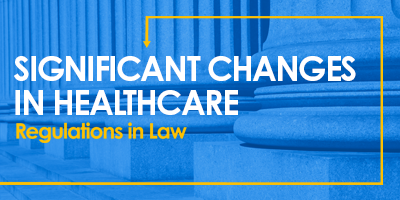A question on many minds across the pharmaceutical industry is how the pending CMS Final Rule on Copay Programs will affect manufacturers. Our clients are asking, “what will this potentially change for my program?” and “is there anything we can do to be prepared?”
We asked Archbow team member Grace Bergin, who has been working day-in and day-out to help our clients make sense of the CMS Final Rule, to give us a background overview, and help us all better understand what this means for copay programs and the patients those programs support.
Grace joined Team Archbow last year, focusing on supporting quality patient access and care. Learn more about Grace here.
What the CMS Final Rule on Copay Programs Means for Pharmaceutical Manufacturers
The CMS Final Rule on copay seeks to address copay assistance dollars that do not go towards “the benefit of the patient” and comes into effect in January 2023. With just nine months to go, it is vital that manufacturers consider how much financial and reputational risk they may face as a result of the Rule, and carefully plan their response.
For decades, well-designed copay programs have helped patients pay for large or unaffordable out-of-pocket (OOP) drug expenses. By subsidizing patients directly, copay programs can help cover affordability gaps between what insurance plans pay for and a patient’s capacity to pay at a given time. While copay programs are an essential affordability tool for many drugs, they are particularly important for high-cost specialty, and often, life-saving medications. These products could cost patients thousands of dollars before the patient’s insurance plan covers a more considerable portion of costs.
OOP maximums vary significantly between insurance plans. As a result, when a manufacturer designs their copay program, they often decide on a maximum program value that could cover any patient. This means that the program value exceeds the annual maximum a patient may have to pay OOP in almost all cases. For example, a patient could have an OOP maximum of $6,000 in their insurance plan, but the manufacturer program would cover up to $20,000 to allow for exceptions or mid-year insurance changes.
However, for PBMs and payers, patients with little or no OOP expenses because of the manufacturer’s assistance have little incentive to select other plan preferred formulary products, resulting in higher costs for the payer and potentially, plan sponsors.
For a quick refresher on how accumulator and maximizer programs work, please see this post on DrugChannels.com.
In both accumulator and maximizer models, the payer is extracting money from the manufacturer instead of the funding going directly to the patient. In this example, the payer is getting $20,000 instead of $6,000, and more still if the patient pays $6,000 OOP themselves after the manufacturer’s $20,000 is exhausted.
The Final Rule “requires manufacturers to “ensure” that patient assistance is provided entirely to patients as a condition of excluding the patient assistance from best price.”* As it stands today, many accumulator and maximizer programs will be treated as a discount on the drug and factored into government price reporting. This change could have catastrophic consequences on the balance sheets of many biopharma manufacturers. Because of the enormous financial risks facing manufacturers, many will have to rethink their financial assistance programs for insured patients completely.
The Final Rule was finalized by CMS in June 2020, with an effective date of January 2023.
What does this mean for manufacturers?
The Rule places responsibility on the manufacturer to ensure that each copay assistance dollar benefits patients, lest the impact on government price reporting. Moreover, since best price calculations are based on the lowest cost sale (as opposed to a weighted average), even a single prescription copay accumulated/maximized could wreak material financial impact on its manufacturer.
While there is no obvious quick fix for manufacturers and their assistance programs, some options could reduce impacts, such as direct-to-patient support through different payment modalities or strategic contracting with payers. Though variables such as the outcome of a PhRMA lawsuit to block the Rule’s implementation are still unresolved, the Rule’s likely implementation is just around the corner.
It is now crucial that manufacturers determine the effects of the Final Rule on their assistance programs for patients taking their medicines and plan how best to manage these new challenges. That’s where Archbow Consulting can help. If your organization could use a better understanding of the Final Rule and guidance on how to best mitigate the potential negative impacts, contact us today to get started.
Archbow Consulting helps pharmaceutical and biotech companies in the USA and Europe design, build, and optimize product distribution and patient access strategies. Archbow was founded by industry veterans to meet a need in the marketplace for consulting options that offer diverse real-world experience, are able to leverage deep connections across the industry, and can also provide actionable strategic guidance. We invite you to learn more about our team, services, and clients’ success, and connect with us via email, LinkedIn or subscribing to this blog which you can do below.



